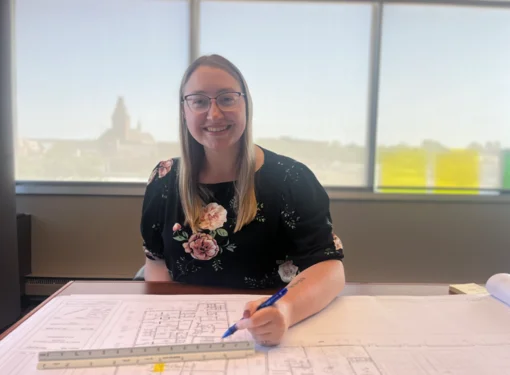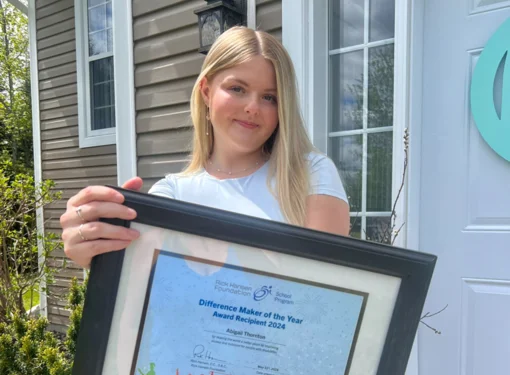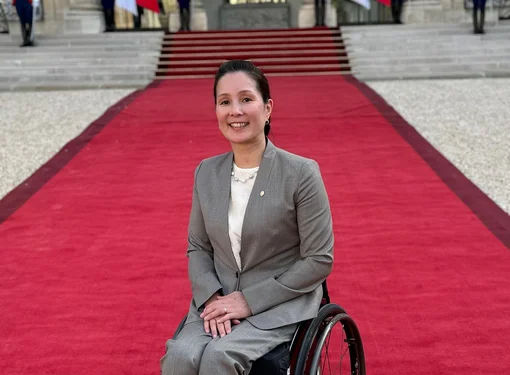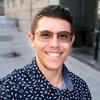The Rick Hansen Accessibility Team at work
Above image: Ellen (left) and Phil (right) of the Rick Hansen Accessibility Team measure an accessible parking spot.
Since its formation this year, the Rick Hansen Accessibility Team is working with businesses and organizations to help make them accessible to the public, through accessibility surveys and valuable input.
So how does it work? The team graciously allowed us to follow them as they demonstrate (quite literally) the tools of their trade and how they work.
Well-rounded perspectives
The Accessibility Team is divided into pairs, with each team member having first-hand knowledge of accessibility challenges, related to anything from mobility to sight loss.
This allows them to make recommendations that are practical, useful, and – most importantly – relevant to their everyday lives.
Measuring up
An integral component of the accessibility survey process is measuring. Everything is measured, from the outside to the inside. This includes entrances, restrooms, lighting and sound levels, and so forth.
This is done to provide the most accurate information possible, since disabilities come in all forms.
Having numbers to work with also allows businesses and organizations to pinpoint areas where improvements can be made – and whether those improvements are major or minor.
 Above image: Team members Mallaz (left) and Marika (right) measure the width of a curb cut.
Above image: Team members Mallaz (left) and Marika (right) measure the width of a curb cut.
 Above image: Marika and fellow team member Phil explore the height of a parking pay machine.
Above image: Marika and fellow team member Phil explore the height of a parking pay machine.
 Above image: Team members Laetitia (right) and Stan (left) work to find out the width of a door.
Above image: Team members Laetitia (right) and Stan (left) work to find out the width of a door.
 Above image: Marika and Mallaz find the height of a sink inside a restroom.
Above image: Marika and Mallaz find the height of a sink inside a restroom.
Tools and equipment
Team members are equipped with all the tools necessary to provide accurate and reliable accessibility surveys.
They have tape measures to determine widths and heights. As well, they use clinometers to measure slope gradients of ramps and inclines.
To determine whether lighting levels are suitable for those who are partially sighted, there is also a tool to measure brightness, in addition to the team members manually checking for contrast and readability of signage.
Brightness can also help those who lip-read or sign, such as people who are Deaf or hard-of-hearing. In addition, sound levels are recorded to determine auditory accessibility.
Each team pairing will measure doors' resistance with weighing scales. This reading helps those with mobility devices, such as wheelchairs, rollators, walkers, or scooters. It is also useful for people using guiding canes or those with reduced arm or upper body strength.
Cameras are used to complement measurements and observations that the team provides; this helps those with specific access needs to determine how the venue's features relate to them.
Each survey is done electronically through a tablet computer, to ensure reliability and speed.
 Above image: Phil determines the slope gradient of a curb cut with a clinometer.
Above image: Phil determines the slope gradient of a curb cut with a clinometer.
 Above image: Laetitia and Stan check the brightness of a room with a Lux reader.
Above image: Laetitia and Stan check the brightness of a room with a Lux reader.
 Above image: Laetitia tests the resistance of a door with a weight scale.
Above image: Laetitia tests the resistance of a door with a weight scale.
 Above image: Marika fills out an accessibility survey with a tablet.
Above image: Marika fills out an accessibility survey with a tablet.
 Above image: Stan takes a photo of an elevator shaft.
Above image: Stan takes a photo of an elevator shaft.
 Above image: Ellen and Phil record the slope and distance of a curb cut in a parking lot.
Above image: Ellen and Phil record the slope and distance of a curb cut in a parking lot.
Does your business or organization want to join in?
If you operate a business or organization and want to improve your accessibility through the Rick Hansen Accessibility Team, they are currently accepting appointments for Vancouver and Richmond, British Columbia. Please act now to take advantage of this free service – it is a limited time offer.
To start, contact the team at teamaccess@rickhansen.com.







